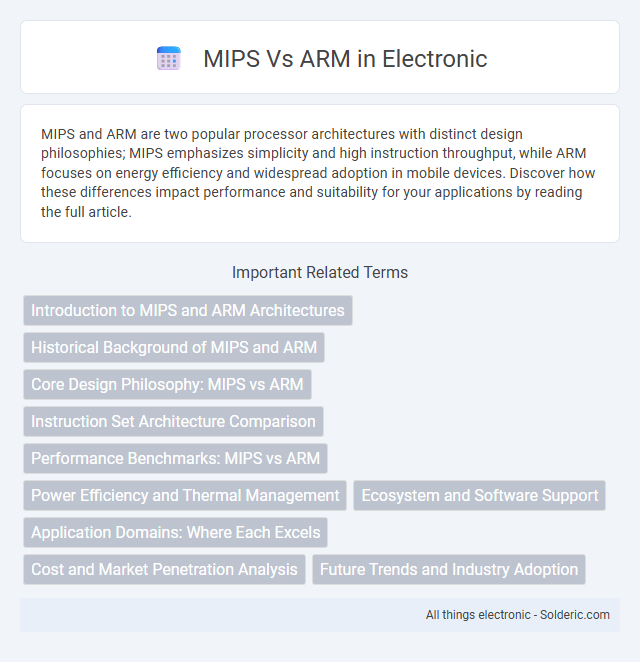MIPS and ARM are two popular processor architectures with distinct design philosophies; MIPS emphasizes simplicity and high instruction throughput, while ARM focuses on energy efficiency and widespread adoption in mobile devices. Discover how these differences impact performance and suitability for your applications by reading the full article.
Comparison Table
| Feature | MIPS | ARM |
|---|---|---|
| Architecture Type | RISC (Reduced Instruction Set Computer) | RISC |
| Instruction Sets | MIPS32, MIPS64 | ARMv7 (32-bit), ARMv8 (64-bit) |
| Usage | Embedded systems, routers, digital TVs | Smartphones, tablets, embedded systems, servers |
| Performance | Efficient for simple designs | High performance with advanced power management |
| Power Consumption | Low to moderate | Optimized for low power devices |
| Licensing | IP licensing with fewer licensees | Widely licensed, extensive ecosystem |
| Market Share | Smaller, niche markets | Dominant in mobile and embedded markets |
| Endianness | Supports both little and big endian | Primarily little endian |
Introduction to MIPS and ARM Architectures
MIPS and ARM architectures represent two distinct RISC (Reduced Instruction Set Computing) designs widely used in embedded systems and processors. MIPS, developed by MIPS Technologies, emphasizes simplicity and high performance with a load/store architecture, while ARM, created by ARM Holdings, offers energy-efficient designs optimized for mobile and low-power devices. Understanding your choice between MIPS and ARM depends on application needs, performance requirements, and power consumption priorities.
Historical Background of MIPS and ARM
MIPS (Microprocessor without Interlocked Pipeline Stages) architecture was developed in the early 1980s by MIPS Computer Systems, known for pioneering RISC (Reduced Instruction Set Computing) principles to enhance processing efficiency. ARM (Advanced RISC Machines), founded in 1990 as a joint venture between Acorn Computers, Apple, and VLSI Technology, focused on low-power consumption and high performance, impacting mobile and embedded systems. Both architectures represent foundational developments in RISC design but have targeted different market applications over time.
Core Design Philosophy: MIPS vs ARM
MIPS core design emphasizes a simplified, fixed instruction set architecture (RISC) aimed at high instruction throughput with a load/store model, prioritizing efficiency and predictability. ARM cores integrate a more versatile instruction set with a focus on power efficiency, incorporating features like conditional execution and extensive pipelining to optimize performance in mobile and embedded systems. Your choice between MIPS and ARM depends on whether streamlined, high-speed operation or energy-efficient, flexible processing suits your application needs better.
Instruction Set Architecture Comparison
MIPS and ARM represent two distinct instruction set architectures (ISAs) with MIPS using a Reduced Instruction Set Computing (RISC) design emphasizing simplicity and pipelined execution, while ARM incorporates a more versatile RISC architecture optimized for power efficiency and performance across diverse applications. MIPS typically features a fixed 32-bit instruction length with a limited number of instruction formats, whereas ARM offers both 32-bit and 16-bit (Thumb) instructions, supporting better code density and flexibility. Choosing between MIPS and ARM impacts your system's processing efficiency, power consumption, and software ecosystem compatibility.
Performance Benchmarks: MIPS vs ARM
MIPS processors demonstrate strong performance in embedded systems with efficient pipeline architectures and low power consumption, excelling in real-time processing benchmarks. ARM processors lead in mobile and high-performance computing with superior energy efficiency and extensive ecosystem support, often outperforming MIPS in multi-core and heterogeneous computing benchmarks. Benchmark comparisons like SPECint and EEMBC consistently show ARM's advantage in scalable performance and optimization for modern workloads.
Power Efficiency and Thermal Management
ARM processors exhibit superior power efficiency due to their RISC architecture and advanced low-power design techniques, making them ideal for battery-powered and mobile devices. MIPS processors, while efficient, typically consume more power under heavy workloads, resulting in increased thermal output and the need for robust cooling solutions. ARM's widespread adoption in smartphones and embedded systems highlights its effectiveness in balancing performance with minimal heat generation.
Ecosystem and Software Support
MIPS architecture offers a specialized ecosystem primarily used in embedded systems, but its software support is limited compared to ARM's extensive, versatile platform favored in mobile, IoT, and high-performance computing. ARM's broad software compatibility includes robust developer tools, a large community, and widespread OS support such as Linux, Android, and Windows, making it easier for you to find resources and optimize applications. The richness of ARM's ecosystem ensures continuous updates and innovations, providing a significant advantage for long-term development and deployment.
Application Domains: Where Each Excels
MIPS architecture excels in embedded systems, networking equipment, and digital consumer devices due to its simplicity and efficiency in handling fixed instruction sets. ARM dominates mobile devices, IoT gadgets, and increasingly, server environments because of its power-efficient design and extensive software ecosystem. Your choice between MIPS and ARM should consider the target application domain's performance, power consumption, and software compatibility requirements.
Cost and Market Penetration Analysis
ARM processors dominate the market with extensive adoption in smartphones, embedded systems, and IoT devices, benefiting from a robust ecosystem and competitive licensing costs, which drive widespread usage. MIPS architecture, while historically significant, faces limited market penetration today, primarily used in niche applications with lower volume, resulting in higher per-unit costs due to reduced economies of scale. Your choice between MIPS and ARM should factor in ARM's cost-efficiency and market availability versus MIPS's specialized application strengths.
Future Trends and Industry Adoption
ARM architecture leads future trends with its growing adoption in mobile, IoT, and embedded systems due to superior energy efficiency and extensive ecosystem support. MIPS faces challenges in maintaining significant market share but finds niche applications in specialized networking and academic research. Industry adoption increasingly favors ARM for its scalability, robust security features, and broad vendor backing.
MIPS vs ARM Infographic

 solderic.com
solderic.com